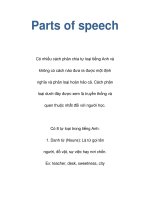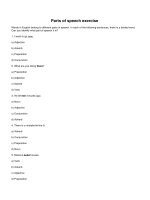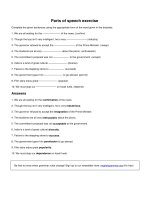Explorer junior library (the parts of speech) conjunctions
Bạn đang xem bản rút gọn của tài liệu. Xem và tải ngay bản đầy đủ của tài liệu tại đây (11.93 MB, 28 trang )
L
GUAGE
N
A RTS
A
EXPLORER
JUNIOR
Conjunctions
so
and
or
but
yet
by Katie Marsico
Cherry Lake Publishing • ann arbor, michigan
text:
A note on the
Certain words
d
are highlighte
f
as examples o
Bold, c
conjunctions.
olorful
words a
re
vocabu
lary wo
Published in the United States of America by Cherry Lake Publishing
rds
Ann Arbor, Michigan
a
n
d can b
www.cherrylakepublishing.com
e found
in the g
lossary
Content Adviser: Lori Helman, PhD, Associate Professor, Department of
.
Curriculum & Instruction, University of Minnesota, Minneapolis, Minnesota
Photo Credits: Page 4, ©Rashevska Nataliia/Shutterstock, Inc.; page
5, ©ETIENjones/Shutterstock, Inc.; page 8, ©iStockphoto.com/
craftvision; page 9, ©06photo/Shutterstock, Inc.; page 10, ©MANDY
GODBEHEAR/Shutterstock, Inc.; page 12, ©David Gilder/Shutterstock,
Inc.; page 14, ©iofoto/Shutterstock, Inc.; page 17, ©ZUMA Press, Inc./
Alamy.; page 18, ©Vasil Vasilev/Shutterstock, Inc.; page19, ©HLPhoto/
Shutterstock, Inc.; page 21, ©Golden Pixels LLC/Shutterstock, Inc.
Copyright ©2014 by Cherry Lake Publishing
All rights reserved. No part of this book may be reproduced or utilized in
any form or by any means without written permission from the publisher.
Library of Congress Cataloging-in-Publication Data
Marsico, Katie, 1980–
Conjunctions / By Katie Marsico.
pages cm. — (Language arts explorer junior)
Includes bibliographical references and index.
ISBN 978-1-62431-181-9 (lib. bdg.) — ISBN 978-1-62431-247-2
(e-book) — ISBN 978-1-62431-313-4 (pbk.)
1. English language—Conjunctions—Juvenile literature. I. Title.
PE1345.M37 2013
428.2—dc23
2013007030
Cherry Lake Publishing would like to acknowledge the work
of The Partnership for 21st Century Skills. Please visit www.p21.org
for more information.
Printed in the United States of America
Corporate Graphics Inc.
July 2013
CLFA13
2
Table of Contents
c ha p t er o ne
A Proud and Excited Artist . . . . . . . . . 4
cha pt er t wo
A Look at Conjunctions . . . . . . . . . . . 8
cha pt er t h r e e
Recognize the Rules! . . . . . . . . . . . . 14
Glossary . . . . . . . . . . . . . . . . . . . . . . 22
For More Information . . . . . . . . . . . 23
Index . . . . . . . . . . . . . . . . . . . . . . . . 24
About the Author . . . . . . . . . . . . . . 24
3
c ha p t er o n e
A Proud and
Excited Artist
Nancy was excit
ed to show off h
er painting.
Nancy headed into the school gym with her
dad and little brother, Mitch. She was both
proud and excited. Her watercolor painting
was in the art show.
“I know my painting is in here somewhere,
though I am not sure exactly where,” said Nancy.
4
includes
A collage often
materials.
many different
“Look, Dad,” said Mitch. “There are
sculptures, sketches, and photographs, too!”
“Of course,” replied Nancy. “The kids in
my class created not only paintings but also
lots of other kinds of art. My friend Josh even
made a collage out of things from his family’s
recycling bin!”
“We should get moving so we can check
out all this amazing work,” said Nancy’s dad.
“Let’s walk toward the back of the gym
until we find Nancy’s painting.”
5
ns are
o
i
t
c
s,
n
u
Conj
k word
n
i
l
t
a
th
.
joiners
clauses
d
n
a
,
s
phrase
S PHRASES CLAUSES
D
R
O
W
Nancy, Mitch, and their father used
conjunctions to link their thoughts about the art
show. Conjunctions are sometimes called joiners.
They can join individual words together.
Conjunctions can also join phrases and
clauses. These are groups of words that have
meaning but are part of a larger sentence.
People would find it hard to communicate
without conjunctions. Sentences would be
shorter, and language would sound choppy. If
conjunctions did not exist, it would also be
difficult to discuss complicated ideas.
6
JUNI
STOP!
DON’’T
T WRITE
IN T
IN
TH
HE BOOK!
Activity
Read and Rethink!
Read the following groups of sentences. Then
connect the ideas in each group into one sentence.
Use the conjunctions listed in parentheses.
What differences do you notice after adding
conjunctions?
1. Nancy liked drawing. She liked sculpting. She
liked photography. (and)
2. Nancy enjoyed painting the most. This was why
she decided to do a painting for the art show.
(because)
3. Nancy had thought about using one of two types
of paint. She had thought about using oil paint.
She had thought about using watercolor paint,
too. (either/or)
Answers may vary, but these are possible examples:
1. Nancy liked drawing, sculpting, and photography.
2. Nancy did a painting for the art show because
she enjoyed painting the most.
3. Nancy had thought about using either oil paint or
watercolor paint.
To get a c
opy of th
is activity
www.cher
, visit
rylakepub
lishing.com
/activitie
s.
7
c ha p t er T wo
A Look at
Conjunctions
Conjunctions are
used to connect
ideas
about several to
pics, including a
rt.
“Hey, Gina,” Nancy said to her friend. “I want
to find my watercolor, but I would like to get a
closer peek at your sculpture first. Did you use
Play-Doh or modeling clay?”
8
“I made this with a mixture of water, flour,
and newspaper,” answered Gina. “It was
messy yet fun!” The words but, or, and, and yet
are conjunctions. With these joiners, no word,
phrase, or clause is given more emphasis than
another. The conjunctions for and so are also
used this way.
For example, Gina used and to connect the
words water, flour, and newspaper. She placed
equal importance on each of the items.
eople
mple of where p
a
x
e
e
n
o
is
st
li
A grocery
ords.
and to connect w
n
o
ti
c
n
ju
n
o
c
e
use th
9
Although Ethan
took many photo
s,
his favorites we
re of his family
.
“If you like photography, then you should stop
by my exhibit,” called Nancy’s friend Ethan.
“Wow, Ethan,” said Nancy’s dad. “When I
saw these photos, I thought a professional
had taken them!”
“I mainly snapped pictures of my family
because they gave me my camera,”
explained Ethan.
10
Some clauses can stand alone as complete
sentences. These are called independent
clauses. Other clauses cannot stand alone.
Instead, they depend on another clause to
make sense. Certain conjunctions are used to
connect such a clause to the rest of the
sentence. The words if, when, and because
are examples. There are several others,
including although, before, once, since, than,
that, unless, where, whether, and while.
For example, the clause “I mainly snapped
pictures of my family,” makes sense on its own.
The clause “because they gave me my
camera” does not. The conjunction because
joins the two clauses together. It helps add
information to the sentence.
Now readers know why
Ethan mainly took photos
of his family.
11
“Either my art teacher forgot about my
painting or it must be hidden somewhere,” said
Nancy sadly.
“Don’t worry, Nancy,” replied Mitch. “Dad
and I would rather look for your watercolor all
night than leave without seeing it!” Some
conjunctions are paired together. Either/or and
rather/than are examples. Others include both/
and, neither/nor, and not only/but also. These
conjunctions link words, phrases, and clauses
that are of equal value within a sentence.
The con
junctio
ns
either a
nd or a
re ofte
used wh
n
en choo
sing
betwee
n two it
ems.
12
LA
A
GE
A
U
NG TS
R
ER
R
O
L
EXP NIOR
JU
OR
R
E
H
EIT
STOP!
DON’T
WRIT
E
IN THE
BOOK
!
Activity
Locate and List!
Locate and list the conjunctions in the following
conversation:
“I love all this art, but the gym is so crowded,”
complained Nancy. “My art teacher should either
find a bigger space next time or put the projects in
three or four different rooms.”
“Relax,” said her dad. “I bet you will feel better
once we find your painting!”
Answers: but, either/or, or, once
To get
a copy
of this
www.ch
activity
errylak
, visit
epublis
hing.co
m/activ
it
ies.
13
c ha p t er t h r e e
Recognize the Rules!
se punctuation
Make sure you u
you write.
correctly when
“Here are the watercolor paintings, but I do not
see yours, Nancy,” said her dad.
“Ooh, some people painted dinosaurs and
robots,” said Mitch excitedly. “Look! There are
even watercolors of monsters, skyscrapers, and
outer space!”
14
People follow certain rules when using
conjunctions. For starters, most conjunctions fall
between the words, phrases, or clauses they
join together.
Punctuation is also important. If a
conjunction links only two words or phrases, no
comma is needed. For example, a comma does
not separate dinosaurs and robots.
Yet if a conjunction joins three or
more words or phrases, commas are
necessary. In the conversation on page
14, commas divide monsters,
skyscrapers, and outer space.
The rule is different when joining
clauses. Sometimes all the clauses are
independent. These clauses would
make sense as separate sentences.
Then writers place a comma before
the connecting conjunction.
15
nk about it
i
h
T
Extra Example
Nancy was having a good time at the art show, but
she was upset that she did not see her painting.
Independent clause #1: Nancy was having a good
time at the art show
Independent clause #2: she was upset that she did
not see her painting
Conjunction: but
What if one of the clauses doesn’t make sense
on its own? The punctuation depends on which
clause comes first.
“I found my painting!” yelled Nancy. “I did
not see it at first because of the huge crowd of
people standing around it.” In the last sentence,
there is no comma before the conjunction
because. No comma is needed when the
independent clause comes first.
16
“Since your painting is so popular, I plan
on displaying it in the coffee shop near my
apartment,” announced Nancy’s teacher. In
this case, the independent clause is “I plan
on displaying it in the coffee shop near my
apartment.” It comes second in the sentence. The
dependent clause and its conjunction are at the
beginning. A comma is therefore necessary.
because so
d
u
o
r
p
s
a
Nancy w
painting.
r
e
h
d
e
k
li
many people
17
“Neither your brother nor I knew you were
such a talented artist,” said Nancy’s father.
“Either you should become a painter, or you
should find a job doing some other form of art.”
“Dad is right,” added Mitch. “You deserve
to win a medal or a trophy. Your painting is
the best art here!”
Nancy’s father
used the conjun
ctions either
and or to discuss
her future as an
artist.
18
,
pes of ice cream
ty
o
tw
ly
on
d
e
m
d.
Because Nancy na
the conjunction an
re
fo
e
b
a
m
m
co
there was no
“Now that you saw my watercolor, I vote
that we go out for ice cream,” said Nancy. “A
scoop of chocolate and a scoop of vanilla
are a good enough prize!” Conjunctions are
not just important in conversations about art
and ice cream. People use them all the time to
link words, clauses, and phrases. Without
19
LA
A
GE
A
U
conjunctions, language would
NG TS be completely
R
different. These parts of speech help
people
R
E
R
O
EXPLNIOR
join ideas and information!
JU
STOP!
DON’T
WRIT
E
IN THE
BOOK
!
Activity
Read and Rethink!
Read the conversation below, and then rewrite it with
the correct punctuation:
“Do you want to invite Gina Ethan and Josh for ice
cream?” asked Nancy’s dad.
“I would love to ask them but I think they need to
pack up their art first,” answered Nancy.
“It will take you a while to find your friends so I
will help you look,” offered Mitch. “It will be easier if
you and I split up.”
“We should decide on a meeting place,” suggested
Nancy’s dad. “Once you gather everyone together
wait by the front door.”
20
ity, visit
f this activ
o
y
p
o
c
a
t
ivities.
To ge
ing.com/act
h
s
li
b
u
p
e
k
la
www.cherry
21
er for people to share
si
ea
it
e
ak
m
ns
io
ct
un
Conj
g.
s in speaking and writin
their thoughts and idea
Answers:
“Do you want to invite Gina, Ethan, and Josh for
ice cream?” asked Nancy’s dad.
“I would love to ask them, but I think they need to
pack up their art first,” answered Nancy.
“It will take you a while to find your friends, so I
will help you look,” offered Mitch. “It will be easier if
you and I split up.”
“We should decide on a meeting place,” suggested
Nancy’s dad. “Once you gather everyone together, wait
by the front door.”
Glossary
clauses (KLAWZ-iz) groups of words that contain a subject and a verb
and form part of a sentence
conjunctions (kuhn-JUHNK-shuhnz) words that join words, phrases,
or clauses together
emphasis (EM-fuh-sis) importance given to something
independent (in-duh-PEN-duhnt) able to stand alone
phrases (FRAY-ziz) groups of words that have meaning but do not
form a sentence
punctuation (puhnk-choo-AY-shuhn) the use of periods, commas, and
other marks to help make the meaning of written material clear
22
For More Information
Book
Fandel, Jennifer. What Is a Conjunction? North Mankato, MN:
Capstone Press, 2013.
Web Site
BrainPOP—Conjunctions
www.brainpop.com/english/grammar/conjunctions/preview.weml
Watch a video that provides more information about conjunctions.
23









